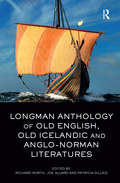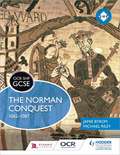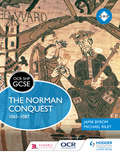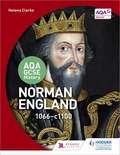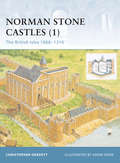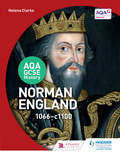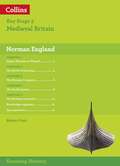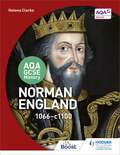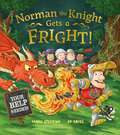Special Collections
Saxons and Vikings
Description: Books and images for project and them based learning about Saxons and Vikings
- Table View
- List View
Longman Anthology of Old English, Old Icelandic, and Anglo-Norman Literatures
by Richard North; Joe Allard; Patricia GilliesThe Longman Anthology of Old English, Old Icelandic and Anglo-Norman Literatures provides a scholarly and accessible introduction to the literature which was the inspiration for many of the heroes of modern popular culture, from The Lord of the Rings to The Chronicles of Narnia, and which set the foundations of the English language and its literature as we know it today. Edited, translated and annotated by the editors of Beowulf and Other Stories, the anthology introduces readers to the rich and varied literature of Britain, Scandinavia and France of the period in and around the Viking Age. Ranging from the Old English epic Beowulf through to the Anglo-Norman texts which heralded the transition Middle English, thematically organised chapters present elegies, eulogies, laments and followed by material on the Viking Wars in the Anglo-Saxon Chronicle, Vikings gods and Icelandic sagas, and a final chapter on early chivalry introduces the new themes and forms which led to Middle English literature, including Arthurian Romances and Chaucer's Canterbury Tales.Laying out in parallel text format selections from the most important Old English, Old Icelandic and Anglo-Norman works, this anthology presents translated and annotated texts with useful bibliographic references, prefaced by a headnote providing useful background and explanation.
Longman Anthology of Old English, Old Icelandic, and Anglo-Norman Literatures
by Richard North and Joe Allard and Patricia GilliesThe Longman Anthology of Old English, Old Icelandic and Anglo-Norman Literatures provides a scholarly and accessible introduction to the literature which was the inspiration for many of the heroes of modern popular culture, from The Lord of the Rings to The Chronicles of Narnia, and which set the foundations of the English language and its literature as we know it today. Edited, translated and annotated by the editors of Beowulf and Other Stories, the anthology introduces readers to the rich and varied literature of Britain, Scandinavia and France of the period in and around the Viking Age. Ranging from the Old English epic Beowulf through to the Anglo-Norman texts which heralded the transition Middle English, thematically organised chapters present elegies, eulogies, laments and followed by material on the Viking Wars in the Anglo-Saxon Chronicle, Vikings gods and Icelandic sagas, and a final chapter on early chivalry introduces the new themes and forms which led to Middle English literature, including Arthurian Romances and Chaucer's Canterbury Tales.Laying out in parallel text format selections from the most important Old English, Old Icelandic and Anglo-Norman works, this anthology presents translated and annotated texts with useful bibliographic references, prefaced by a headnote providing useful background and explanation.
OCR GCSE History SHP
by Michael Fordham and Jamie Byrom and Michael RileyAn OCR endorsed textbook Let SHP successfully steer you through the new specification with an exciting, enquiry-based series that invigorates teaching and learning; combining best practice principles and worthwhile tasks to develop students' high-level historical knowledge and skills. - Tackle unfamiliar topics from the broadened curriculum with confidence: the engaging, accessible text covers the content you need for teacher-led lessons and independent study - Ease the transition to GCSE: step-by-step enquiries inspired by best practice in KS3 help to simplify lesson planning and ensure continuous progression within and across units - Build the knowledge and understanding students need to succeed: the scaffolded three-part task structure enables students to record, reflect on and review their learning - Boost student performance across the board: suitably challenging tasks encourage high achievers to excel at GCSE while clear explanations make key concepts accessible to all - Rediscover your enthusiasm for source work: a range of purposeful, intriguing visual and written source material is embedded at the heart of each investigation to enhance understanding - Develop students' sense of period: the visually stimulating text design uses memorable case studies, diagrams, infographics and contemporary photos to bring fascinating events and people to life
OCR GCSE History SHP
by Michael Riley and Jamie ByromAn OCR endorsed textbookLet SHP successfully steer you through the new specification with an exciting, enquiry-based series that invigorates teaching and learning; combining best practice principles and worthwhile tasks to develop students' high-level historical knowledge and skills.- Tackle unfamiliar topics from the broadened curriculum with confidence: the engaging, accessible text covers the content you need for teacher-led lessons and independent study- Ease the transition to GCSE: step-by-step enquiries inspired by best practice in KS3 help to simplify lesson planning and ensure continuous progression within and across units- Build the knowledge and understanding students need to succeed: the scaffolded three-part task structure enables students to record, reflect on and review their learning- Boost student performance across the board: suitably challenging tasks encourage high achievers to excel at GCSE while clear explanations make key concepts accessible to all- Rediscover your enthusiasm for source work: a range of purposeful, intriguing visual and written source material is embedded at the heart of each investigation to enhance understanding- Develop students' sense of period: the visually stimulating text design uses memorable case studies, diagrams, infographics and contemporary photos to bring fascinating events and people to life
AQA GCSE History
by Helena ClarkeCreate a stimulating, well-paced teaching route through the 2016 GCSE History specification using this tailor-made series that draws on a legacy of market-leading history textbooks and the individual subject specialisms of the author team to inspire student success. - Motivate your students to deepen their subject knowledge through an engaging and thought-provoking narrative that makes historical concepts accessible and interesting to today's learners - Embed progressive skills development in every lesson with carefully designed Focus Tasks that encourage students to question, analyse and interpret key topics - Take students' historical understanding to the next level by using a wealth of original contemporary source material to encourage wider reflection on different periods - Help your students achieve their potential at GCSE with revision tips and practice questions geared towards the changed assessment model, plus useful advice to aid exam preparation - Confidently navigate the new AQA specification using the expert insight of experienced authors and teachers with examining experience About this book Norman England is an authoritative textbook for the new AQA British Depth Study: Norman England 1066-1100. It covers: Part One: Conquest and Control - Causes of conquest: Why did the Normans invade and conquer England? - The Battle of Hastings: Why did William win the Battle of Hastings in 1066? - Establishing control: How did William deal with rebellions and start to take control of the country? Part Two: Taking Stock - Feudalism: How was the country organised under the Feudal system? - Domesday book: Why was the Domesday survey compiled & what can be learnt from it? - The Medieval Village: What was life like for ordinary people? Part Three: The Normans and Monasticism - The Church: To what extent did William change the English Church? - Monasticism: How did monasteries change after the Norman conquest? Norman England is written by the Helena Clarke who has taught History at Wilmslow High School for 10 years and is also team leader for GCSE History for a major awarding body. 9781471864254
Norman Lord and Lady of the Manor (Large Print)
byThis image shows a Norman Lord to the left of the page and a Norman Lady to the right. They are both facing forward so that all their facial features and limbs can be seen. There is a locator dot shown, which will be at the top left of the page when the image is the right way up. At the top left of the page is the Lord's head. He is wearing a floppy hat which hangs down to the left. Down the page are his fringe and his face, with an ear on either side. Down again, his cloak can be found draped over his shoulders and hanging behind him. He holds his arms out to either side of his body. Under his cloak he wears a long gown, which reaches to his boots at the bottom of the page. At waist level he is wearing a belt with a purse hanging down from it on the left.At the top right of the page is the Lady's head. She is wearing a small cap and down from this her face and ears can be found, with her long hair falling to either side and disappearing behind her back. Down the page she is wearing an ankle-length gown and holds her arms out to either side to show its full sleeves hanging down to calf-length. She wears a knotted cord, which is wrapped twice around her waist. At the bottom of the page are her feet, shod in leather shoes.
Norman Stone Castles
by Adam Hook and Christopher GravettDescended from the Viking raiders who settled in Northern France under the leadership of Rollo in around 911, the Normans were amongst the most feared warriors of their time. Their territorial ambitions culminated in Duke William 1's conquest of England in 1066, but although victory at Hastings left the English crown in William's hands, Norman sovereignty remained far from established on the island. In order to consolidate his position, the new king built a series of fortifications across the country this book covers all these developments from the early days of William I through to the fortifications of Henry II, Richard I and John.
Norman Lord and Lady of the Manor (large print)
by RnibThis image shows a Norman Lord to the left of the page and a Norman Lady to the right. They are both facing forward so that all their facial features and limbs can be seen. There is a locator dot shown, which will be at the top left of the page when the image is the right way up. At the top left of the page is the Lord's head. He is wearing a floppy hat which hangs down to the left. Down the page are his fringe and his face, with an ear on either side. Down again, his cloak can be found draped over his shoulders and hanging behind him. He holds his arms out to either side of his body. Under his cloak he wears a long gown, which reaches to his boots at the bottom of the page. At waist level he is wearing a belt with a purse hanging down from it on the left.At the top right of the page is the Lady's head. She is wearing a small cap and down from this her face and ears can be found, with her long hair falling to either side and disappearing behind her back. Down the page she is wearing an ankle-length gown and holds her arms out to either side to show its full sleeves hanging down to calf-length. She wears a knotted cord, which is wrapped twice around her waist. At the bottom of the page are her feet, shod in leather shoes.
Norman Lord and Lady of the Manor (UEB uncontracted)
by RnibThis image shows a Norman Lord to the left of the page and a Norman Lady to the right. They are both facing forward so that all their facial features and limbs can be seen. There is a locator dot shown, which will be at the top left of the page when the image is the right way up. At the top left of the page is the Lord's head. He is wearing a floppy hat which hangs down to the left. Down the page are his fringe and his face, with an ear on either side. Down again, his cloak can be found draped over his shoulders and hanging behind him. He holds his arms out to either side of his body. Under his cloak he wears a long gown, which reaches to his boots at the bottom of the page. At waist level he is wearing a belt with a purse hanging down from it on the left.At the top right of the page is the Lady's head. She is wearing a small cap and down from this her face and ears can be found, with her long hair falling to either side and disappearing behind her back. Down the page she is wearing an ankle-length gown and holds her arms out to either side to show its full sleeves hanging down to calf-length. She wears a knotted cord, which is wrapped twice around her waist. At the bottom of the page are her feet, shod in leather shoes.
Norman Lord and Lady of the Manor (UEB contracted)
by RnibThis image shows a Norman Lord to the left of the page and a Norman Lady to the right. They are both facing forward so that all their facial features and limbs can be seen. There is a locator dot shown, which will be at the top left of the page when the image is the right way up. At the top left of the page is the Lord's head. He is wearing a floppy hat which hangs down to the left. Down the page are his fringe and his face, with an ear on either side. Down again, his cloak can be found draped over his shoulders and hanging behind him. He holds his arms out to either side of his body. Under his cloak he wears a long gown, which reaches to his boots at the bottom of the page. At waist level he is wearing a belt with a purse hanging down from it on the left.At the top right of the page is the Lady's head. She is wearing a small cap and down from this her face and ears can be found, with her long hair falling to either side and disappearing behind her back. Down the page she is wearing an ankle-length gown and holds her arms out to either side to show its full sleeves hanging down to calf-length. She wears a knotted cord, which is wrapped twice around her waist. At the bottom of the page are her feet, shod in leather shoes.
Norman Lord and Lady of the Manor (UEB Uncontracted)
byThis image shows a Norman Lord to the left of the page and a Norman Lady to the right. They are both facing forward so that all their facial features and limbs can be seen. There is a locator dot shown, which will be at the top left of the page when the image is the right way up. At the top left of the page is the Lord's head. He is wearing a floppy hat which hangs down to the left. Down the page are his fringe and his face, with an ear on either side. Down again, his cloak can be found draped over his shoulders and hanging behind him. He holds his arms out to either side of his body. Under his cloak he wears a long gown, which reaches to his boots at the bottom of the page. At waist level he is wearing a belt with a purse hanging down from it on the left.At the top right of the page is the Lady's head. She is wearing a small cap and down from this her face and ears can be found, with her long hair falling to either side and disappearing behind her back. Down the page she is wearing an ankle-length gown and holds her arms out to either side to show its full sleeves hanging down to calf-length. She wears a knotted cord, which is wrapped twice around her waist. At the bottom of the page are her feet, shod in leather shoes.
AQA GCSE History
by Helena ClarkeCreate a stimulating, well-paced teaching route through the 2016 GCSE History specification using this tailor-made series that draws on a legacy of market-leading history textbooks and the individual subject specialisms of the author team to inspire student success.- Motivate your students to deepen their subject knowledge through an engaging and thought-provoking narrative that makes historical concepts accessible and interesting to today's learners- Embed progressive skills development in every lesson with carefully designed Focus Tasks that encourage students to question, analyse and interpret key topics- Take students' historical understanding to the next level by using a wealth of original contemporary source material to encourage wider reflection on different periods- Help your students achieve their potential at GCSE with revision tips and practice questions geared towards the changed assessment model, plus useful advice to aid exam preparation- Confidently navigate the new AQA specification using the expert insight of experienced authors and teachers with examining experienceAbout this bookNorman England is an authoritative textbook for the new AQA British Depth Study: Norman England 1066-1100. It covers:Part One: Conquest and Control - Causes of conquest: Why did the Normans invade and conquer England?- The Battle of Hastings: Why did William win the Battle of Hastings in 1066?- Establishing control: How did William deal with rebellions and start to take control of the country?Part Two: Taking Stock- Feudalism: How was the country organised under the Feudal system?- Domesday book: Why was the Domesday survey compiled & what can be learnt from it?- The Medieval Village: What was life like for ordinary people?Part Three: The Normans and Monasticism- The Church: To what extent did William change the English Church?- Monasticism: How did monasteries change after the Norman conquest?Norman England is written by the Helena Clarke who has taught History at Wilmslow High School for 10 years and is also team leader for GCSE History for a major awarding body.
Norman Lord and Lady of the Manor (UEB Contracted)
byThis image shows a Norman Lord to the left of the page and a Norman Lady to the right. They are both facing forward so that all their facial features and limbs can be seen. There is a locator dot shown, which will be at the top left of the page when the image is the right way up. At the top left of the page is the Lord's head. He is wearing a floppy hat which hangs down to the left. Down the page are his fringe and his face, with an ear on either side. Down again, his cloak can be found draped over his shoulders and hanging behind him. He holds his arms out to either side of his body. Under his cloak he wears a long gown, which reaches to his boots at the bottom of the page. At waist level he is wearing a belt with a purse hanging down from it on the left.At the top right of the page is the Lady's head. She is wearing a small cap and down from this her face and ears can be found, with her long hair falling to either side and disappearing behind her back. Down the page she is wearing an ankle-length gown and holds her arms out to either side to show its full sleeves hanging down to calf-length. She wears a knotted cord, which is wrapped twice around her waist. At the bottom of the page are her feet, shod in leather shoes.
Side view of a Norman catapult(UEB Contracted)
byThis diagram shows a Norman catapult from the side, so that only two of its four wheels are visible. There is a locator dot shown, which will be at the top left of the page when the image is the right way up. The catapult is firing a projectile (a large rock) from the catapult arm. The catapult, the projectile and the direction of fire have been labelled. In the left centre of the page is the released retraction rope attached to a cup on the arm of the catapult. Slightly up from this is a projectile that is being released and is flying up and to the right. The arm extends to the right where it rotates around a pivot on the base. The arm continues further to the right where there is a counterweight basket hanging down the page from it. To the right of the basket there is an arrow pointing downward, showing its direction of travel. At the bottom of the page is the catapult's base with a wheel at the right and left.
Knowing History - KS3 HISTORY NORMAN ENGLAND (PDF)
by Robert PealReady-made high quality KS3 history lessons on the Norman Conquest - topic booklet perfect for a half term's work. Give every student access to high quality KS3 History textbook content with this topic booklet on the Norman Conquest. Chapter 1: Saxon, Norman or Viking? Chapter 2: The Battle of Hastings Chapter 3: The Norman Conquest Chapter 4: The Feudal System Chapter 5: The Norman Monarchs * Fits into the school timetable with ease with 5 high quality lessons, perfect for a half term * Ignites an interest in history through extraordinary people, amazing facts, and a distinctly engaging narrative * Helps all students to think critically about the past by focusing on the knowledge they need and then checking their understanding * Aids pupil memory with a 'knowledge organiser' at the back with key dates, vocabulary and significant people. * Delivers excellent lessons and saves time planning with the Teacher Guide available free on Collins.co.uk, containing teaching ideas, suggested sources, assessment, answers, essay titles and extended writing examples
A Norman cavalry man and horse (large print)
by RnibThis is an image of a cavalryman facing forward and standing on the left of the page beside his large horse. There is a locator dot shown, which will be at the top left of the page when the image is the right way up. The horse is viewed from the side and its head is to the left of the page next to the cavalryman. The man is holding the rein of the horse in his left hand and in his right hand he is holding a sword. He is dressed in a knee-length, short-sleeved tunic tied loosely at the waist and he wears a helmet with strong metal bands to protect his head and face. He is wearing shoes with long laces, which criss-cross around his calves. He has a kite-shaped shield, which is rounded at the top and pointed at the bottom. The cavalryman's horse has a high-backed saddle to give the rider more stability when he is in combat.
A Norman cavalry man and horse (UEB uncontracted)
by RnibThis is an image of a cavalryman facing forward and standing on the left of the page beside his large horse. There is a locator dot shown, which will be at the top left of the page when the image is the right way up. The horse is viewed from the side and its head is to the left of the page next to the cavalryman. The man is holding the rein of the horse in his left hand and in his right hand he is holding a sword. He is dressed in a knee-length, short-sleeved tunic tied loosely at the waist and he wears a helmet with strong metal bands to protect his head and face. He is wearing shoes with long laces, which criss-cross around his calves. He has a kite-shaped shield, which is rounded at the top and pointed at the bottom. The cavalryman's horse has a high-backed saddle to give the rider more stability when he is in combat.
A Norman cavalry man and horse (UEB contracted)
by RnibThis is an image of a cavalryman facing forward and standing on the left of the page beside his large horse. There is a locator dot shown, which will be at the top left of the page when the image is the right way up. The horse is viewed from the side and its head is to the left of the page next to the cavalryman. The man is holding the rein of the horse in his left hand and in his right hand he is holding a sword. He is dressed in a knee-length, short-sleeved tunic tied loosely at the waist and he wears a helmet with strong metal bands to protect his head and face. He is wearing shoes with long laces, which criss-cross around his calves. He has a kite-shaped shield, which is rounded at the top and pointed at the bottom. The cavalryman's horse has a high-backed saddle to give the rider more stability when he is in combat.
Side view of a Norman catapult (Large Print)
byThis diagram shows a Norman catapult from the side, so that only two of its four wheels are visible. There is a locator dot shown, which will be at the top left of the page when the image is the right way up. The catapult is firing a projectile (a large rock) from the catapult arm. The catapult, the projectile and the direction of fire have been labelled. In the left centre of the page is the released retraction rope attached to a cup on the arm of the catapult. Slightly up from this is a projectile that is being released and is flying up and to the right. The arm extends to the right where it rotates around a pivot on the base. The arm continues further to the right where there is a counterweight basket hanging down the page from it. To the right of the basket there is an arrow pointing downward, showing its direction of travel. At the bottom of the page is the catapult's base with a wheel at the right and left.
Side view of a Norman catapult (UEB Uncontracted)
byThis diagram shows a Norman catapult from the side, so that only two of its four wheels are visible. There is a locator dot shown, which will be at the top left of the page when the image is the right way up. The catapult is firing a projectile (a large rock) from the catapult arm. The catapult, the projectile and the direction of fire have been labelled. In the left centre of the page is the released retraction rope attached to a cup on the arm of the catapult. Slightly up from this is a projectile that is being released and is flying up and to the right. The arm extends to the right where it rotates around a pivot on the base. The arm continues further to the right where there is a counterweight basket hanging down the page from it. To the right of the basket there is an arrow pointing downward, showing its direction of travel. At the bottom of the page is the catapult's base with a wheel at the right and left.
AQA GCSE History
by Helena ClarkeCreate a stimulating, well-paced teaching route through the 2016 GCSE History specification using this tailor-made series that draws on a legacy of market-leading history textbooks and the individual subject specialisms of the author team to inspire student success.- Motivate your students to deepen their subject knowledge through an engaging and thought-provoking narrative that makes historical concepts accessible and interesting to today's learners- Embed progressive skills development in every lesson with carefully designed Focus Tasks that encourage students to question, analyse and interpret key topics- Take students' historical understanding to the next level by using a wealth of original contemporary source material to encourage wider reflection on different periods- Help your students achieve their potential at GCSE with revision tips and practice questions geared towards the changed assessment model, plus useful advice to aid exam preparation- Confidently navigate the new AQA specification using the expert insight of experienced authors and teachers with examining experienceAbout this bookNorman England is an authoritative textbook for the new AQA British Depth Study: Norman England 1066-1100. It covers:Part One: Conquest and Control - Causes of conquest: Why did the Normans invade and conquer England?- The Battle of Hastings: Why did William win the Battle of Hastings in 1066?- Establishing control: How did William deal with rebellions and start to take control of the country?Part Two: Taking Stock- Feudalism: How was the country organised under the Feudal system?- Domesday book: Why was the Domesday survey compiled & what can be learnt from it?- The Medieval Village: What was life like for ordinary people?Part Three: The Normans and Monasticism- The Church: To what extent did William change the English Church?- Monasticism: How did monasteries change after the Norman conquest?Norman England is written by the Helena Clarke who has taught History at Wilmslow High School for 10 years and is also team leader for GCSE History for a major awarding body.
Norman the Knight Gets a Fright
by Mark Sperring and Ed EavesMeet Norman the Brave:He's in need of some knavesto help him get ready for royal parades.Can you protect Norman? Can you polish his armour? Darn his socks? Feed his horse? Could this be the job for you? Or is being a knave more difficult than it seems?Fire-breathing dragons, trusty steeds, bandits, brigands and ... a pair of medieval pants – you'll find them all in this fun adventure for brave knights everywhere.
An Anglo-Norman Reader
by Jane BlissThis book is an anthology with a difference. It presents a distinctive variety of Anglo-Norman works, beginning in the twelfth century and ending in the nineteenth, covering a broad range of genres and writers, introduced in a lively and thought-provoking way. Facing-page translations, into accessible and engaging modern English, are provided throughout, bringing these texts to life for a contemporary audience. The collection offers a selection of fascinating passages, and whole texts, many of which are not anthologised or translated anywhere else. It explores little-known byways of Arthurian legend and stories of real-life crime and punishment; women’s voices tell history, write letters, berate pagans; advice is offered on how to win friends and influence people, how to cure people’s ailments and how to keep clear of the law; and stories from the Bible are retold with commentary, together with guidance on prayer and confession. Each text is introduced and elucidated with notes and full references, and the material is divided into three main sections: Story (a variety of narrative forms), Miscellany (including letters, law and medicine, and other non-fiction), and Religious (saints' lives, sermons, Bible commentary, and prayers). Passages in one genre have been chosen so as to reflect themes or stories that appear in another, so that the book can be enjoyed as a collection or used as a resource to dip into for selected texts. This anthology is essential reading for students and scholars of Anglo-Norman and medieval literature and culture. Wide-ranging and fully referenced, it can be used as a springboard for further study or relished in its own right by readers interested to discover Anglo-Norman literature that was written to amuse, instruct, entertain, or admonish medieval audiences.
Norman weapons (UEB Uncontracted)
byThis page has three images on it: a bow and arrow on the left, a flail at the bottom centre and a crossbow on the right. There is a locator dot shown, which will be at the top left of the page when the image is the right way up. The string of the bow is held under tension at the far left of the page. Halfway down the length of the string, the end of the arrow can be found with its fletchings (feathers), which stabilize its flight. The arrow extends to the right, passing over the handle of the bow and ending in a sharp pointed head. When the string is released, it throws the arrow forward with great force; it can travel for a distance of more than a kilometre. At the bottom centre of the page is a deadly flail. At the top of the image there is a loop with a chain hanging down from it. At the other end of the chain is a heavy metal spiked ball, at the bottom of the page. The handle of the flail is to the right of this and is used to swing the ball. It was a fearsome weapon that could pierce body armour but was not much favoured, as the sword was held in such high esteem.On the right of the page is a crossbow facing towards the top of the page. It is a small bow fixed to a stock (handle) and has a trigger (this cannot be seen in the diagram) that when pulled, releases the string and throws the bolt (small arrow) forward. The head of the bolt is at the top of the image and further down the bow extends to each side. Its taut string is fixed to each end and held in the middle of the stock, down from the fletchings (feathers) of the bolt. At the bottom of the page is the stock of the crossbow.
Norman weapons (Large Print)
byThis page has three images on it: a bow and arrow on the left, a flail at the bottom centre and a crossbow on the right. There is a locator dot shown, which will be at the top left of the page when the image is the right way up. The string of the bow is held under tension at the far left of the page. Halfway down the length of the string, the end of the arrow can be found with its fletchings (feathers), which stabilize its flight. The arrow extends to the right, passing over the handle of the bow and ending in a sharp pointed head. When the string is released, it throws the arrow forward with great force; it can travel for a distance of more than a kilometre. At the bottom centre of the page is a deadly flail. At the top of the image there is a loop with a chain hanging down from it. At the other end of the chain is a heavy metal spiked ball, at the bottom of the page. The handle of the flail is to the right of this and is used to swing the ball. It was a fearsome weapon that could pierce body armour but was not much favoured, as the sword was held in such high esteem.On the right of the page is a crossbow facing towards the top of the page. It is a small bow fixed to a stock (handle) and has a trigger (this cannot be seen in the diagram) that when pulled, releases the string and throws the bolt (small arrow) forward. The head of the bolt is at the top of the image and further down the bow extends to each side. Its taut string is fixed to each end and held in the middle of the stock, down from the fletchings (feathers) of the bolt. At the bottom of the page is the stock of the crossbow.
